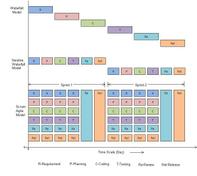Project Management Tutorial: Knowledge Areas, PMP, and Agile
Advertisement
This Project Management tutorial covers Project management knowledge areas, PMP, PMP formulas, Passing PMP Exam, and Agile scrum methodology.
Introduction
This Project Management tutorial covers project management knowledge areas, Managing project professionally (PMP) basics, PMP Exam related stuff, PMP formulas, and software development life cycles (waterfall and Agile scrum models).
Project Management Knowledge Areas
Project Management is the management of projects with a predefined goal to achieve for the benefit of the stakeholders of the project. Any project will have start and end dates, and goals to achieve are predefined.
Project management involves 5 process groups and 9 knowledge areas under which all the project management processes are mapped. Any project goes through a cycle called the project life cycle, which involves the initiation phase, planning, executing, monitoring & control, and closing phase.
Following are the knowledge areas in any project:
Project Integration Management
This phase starts with a project charter, which defines the goal and need of the project and gives the project manager the authority to manage the project. This phase helps all stakeholders work towards the same goal and take care of any changes throughout the project life cycle.
Project Scope Management
This phase defines the scope of the project, which is nothing but features/specifications/acceptance criteria to be achieved at the end of the project. It involves basically scope definition, scope verification, and scope control.
Project Time Management
This involves mainly the development of a schedule/plan for the project and controlling/managing the project plan. This involves managing to meet the milestones/deadlines defined at the start of the project to satisfy the stakeholders, including external customers.
It includes dividing the work into various activities, sequencing of the activities (order in which to execute), resource allocations to each activity, and duration estimation of the activities.

Project Cost Management
Estimate the cost to be incurred to execute the project from start to the end and tracking/controlling the budget. This helps complete the project under budget and avoid the situation of overspending in a project.
Project Quality Management
This helps meet project quality requirements defined at the start, i.e., meet acceptance criteria and other features as planned. Will help keep the project on the right track with respect to the quality. In order to achieve the quality goal of a project, quality assurance is done periodically. Quality audits are planned for the same.
Project Human Resource Management
This phase involves hiring the people to do the work on the project, train the people, and manage them.
Project Communication Management
This helps improve the communication chain, i.e., who are the people responsible for so and so task and who should communicate with whom. This involves the identification of the stakeholders of the project and communication plan. It also defines communication methods, i.e., written/verbal, and so on. This helps avoid communication-related problems in a project and helps two parties communicate information efficiently.
Project Risk Management
This involves the identification of risks involved at the start of the project and managing them throughout the project. It also involves the management of any unplanned risks that may occur over the course of the project. This requires qualitative and quantitative risk analysis to be performed.
Project Procurement Management
This involves make-and-buy decisions for any project. It means whether the project can be contracted to the outside party or get it done locally by hiring the people. It also involves planning for any procurement, executing it, and closing if the procurement/purchase is done.
Advertisement
 RF
RF


